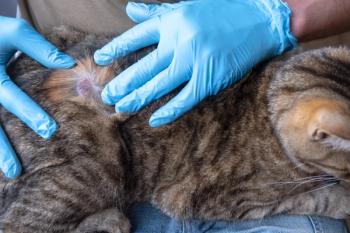
Clients spending more before stopping treatment, DVMs say
Cleveland--The economic cap on veterinary care is rising, DVMs say.
Cleveland-The economic cap on veterinary care is rising, DVMs say.
In an exclusive state of the profession survey, veterinarians were asked to estimate the total dollar amount in which most clients would refuse or stop treatment. The average for 2003 was $961 - a 21 percent increase over the 2000 average of $795. In 1997, the average stop-treatment point was $576 (Table 1).
Table 1: Estimate the total dollar amount at which most of your clients would refuse or stop treatment for their pets
DVM Newsmagazine's survey was mailed to 1,500 U.S. practitioners. Three hundred fifty-two veterinarians responded to the survey achieving a 23 percent response rate with a ± 5 percent error (Methodology, p. 29).
In regard to the stop-treatment average, a great disparity was cited in the survey when the results were cross-tabulated by the type of species treated. In fact, the average stop-treatment point for exclusive companion animal practitioners tipped the scales at $1,087, while the average dropped significantly for predominantly small animal practitioners, $587, and mixed practitioners, $599.
Table 2: Estimate the total dollar amount at which most of your clients would refuse or stop treatment for their pets
When these data were broken out by practice gross revenues, the stop-treatment estimate also declined significantly. In practices generating less than $250,000 in gross revenue, the average dropped to $729, whereas larger grossing practices ($750,000-plus) the average jumped 46 percent to $1,061 (Table 2).
A disparity in answers also exists between men and women respondents. In fact, women exacted a 10 percent higher stop-treatment average than men ($927 average for men, and $1,020 average for women). This economic trend also was cited by owners, partners and associates in practice. Owners' stop-treatment average was $1,012, while partners capped treatment at an average of $815 and associates, $825.
Table 3: Over the past 12 months, to what extent has cost affected your clients' decisions to treat (or continue treatment of) sick or injuredanimals?
The survey shows that cost is a limiting factor for treatment for 41 percent of clients.
The trend line from DVM Newsmagazine surveys conducted in 1997, 2000 and 2003 was consistent. The surveys asked: "Over the past 12 months, to what extent has cost affected your clients' decisions to treat (or continue treatment of) sick or injured animals?" In 2003, veterinarians believe that about 60 percent of their client base says cost did not limit treatment of sick or injured animals (Table 3). Under the category, "cases for which cost was a factor, but client agreed to recommended treatment," some interesting differences were noted by respondents. The average percentage actually increased along with gross revenue. For example, respondents estimating "cases for which cost was a factor, but client agreed to recommended treatment" include:
Table 4: What percent of euthanasias are client requested or doctor suggested?
- Less than $250,000 gross: 29.7 percent
- $250,000-$499,000: 28.9 percent
- $500,000-$749,000: 34.5 percent
- More than $750,000: 38.5 percent
Practitioners in larger grossing practices say that cost is an issue with clients, but they are still forging ahead with treatment. Larger grossing practices also report higher dollar average stop-treatment points and are more willing to accept pet insurance.
Power of suggestion
Euthanasia remains a client-requested service as opposed to "doctor-recommended." On average, 72.5 percent of clients request euthanasias, while 27 percent are doctor-suggested (Table 4).
Methodology
The average number of euthanasias conducted in a typical month dropped slightly. The average number of dogs euthanized in a month was 8.5, while the number of cats was 6.7. In DVM Newsmagazine's 2000 survey, the average number of dogs was 10.9, while cats averaged 8.3.
Euthanasia numbers also increased proportionately when measured by practice gross. For example, dog euthanasia averages included:
- Less than $250,000 gross: 4.2
- $250,000-$499,000: 5.8
- $500,000-$749,000: 7.8
- More than $750,000: 10.7
Client requests to euthanize healthy animals is not a rare event, and in the majority of cases it is caused by a behavior problem, veterinarians say. In extreme cases, some veterinarians report it happens every week. Only 7.6 percent of the veterinarian respondents say it never happens.
Of the survey respondents, 5.6 percent say they are asked to euthanize healthy animals weekly, while 7.1 percent say it happens several times a month. About 9 percent say this request comes in every month, while 40 percent say owners ask to put down healthy pets several times a year. About 29 percent of the respondents say it happens yearly or less frequently.
Table 5: How often are you approached to euthanize healthy animals?
When these data are broken out by practice size, differences are noted (Table 5).
Behavior problems is also the most popular reason for requests to euthanize healthy animals, veterinarians say.
In fact, 79 percent of the most common reasons cited by veterinarians were behavior related. The survey asked: "What are the primary reasons behind requests to euthanize healthy animals?" The top reasons include:
- Behavior problems: 46 percent
- Aggression (i.e. biting): 22.8 percent
- Inappropriate urination/sanitary concerns: 9.6 percent.
- Owner moving: 22.2 percent
- Death of an owner: 7.1 percent
- Old age: 8.4 percent
- Unable to care for pet: 10 percent
It's important to note that financial considerations did not rank in the top categories for respondents. An inability to afford veterinary bills was only mentioned by 6.8 percent of survey respondents.
Veterinarians also believe that behavior consulting is an opportunity. About 34 percent of survey respondents say they are doing more behavior consulting today compared to three years ago. About 47 percent say they are doing the same amount of behavior consulting, while only 2 percent say they are doing less behavior consulting. About 21 percent of survey respondents say they don't provide it.
Table 6: Do you accept pet health insurance? Table 7: Would you like to see wider use of pet health insurance by pet owners? Table 8: Do you actively recommend pet insurance to clients?
Pet health insurance
The survey also documents a much broader acceptance of pet health insurance over the three consecutive survey periods.
In 2003, 76 percent of respondents say they accept pet health insurance. In 2000, 67 percent of veterinarians said they accepted a third-party payment option, while in 1997, only 43 percent could make the same claim (Table 6).
The 2003 survey also noted some regional differences on acceptance of pet health insurance. Practitioners in the South were least likely (66.4 percent) to accept pet health insurance, while the veterinarians in the Northeast were most likely (91 percent) to accept it. The Midwest accounted for a 73.3 percent acceptance rate and the Mountain and Pacific region accounted for 88 percent acceptance.
Veterinarians add they would like to see wider use of pet health insurance by pet owners. Of the respondents in the 2003 survey, 68 percent would like to see more pet owners buy insurance policies to cover veterinary care costs.
In contrast, veterinarians are not actively promoting the service. In 2003, 57 percent say they do not actively recommend pet health insurance to their clients, even though they accept it. However, the three consecutive surveys do show an acceptance trend. In 2003, 43 percent actively recommended insurance as an option. In 2000, 40 percent of veterinarians said they actively recommend it. In 1997, 30 percent said they recommended pet health insurance.
The recommendation for pet health insurance is coming from smaller practices too. More than one-half of single doctor practices say they recommend pet health insurance, while the numbers drop as the practice size increases. For example, two to three doctor practices drop to 37.4 percent and four or more doctor practices are at 36.1 percent.
For the 82 respondents who do not accept pet health insurance about 42 percent say it is because of limited demand by clients, another 14.8 percent say administration of the program is "a hassle" or it's "too much work."
About one-third of veterinarians responding to the survey say more clients are insuring their pets today compared to three years ago, and another 64 percent say it is at about the same level.
When the data is cross-tabulated by region, 43.2 percent of practitioners in the Northeast say more pet owners are insuring pets today, while 27 percent of DVMs in the South say the same.
Most responding veterinarians are not sponsoring their own annual HMO program (96.7 percent). When asked if they ever considered it, about 17 percent say they have considered it.
Newsletter
From exam room tips to practice management insights, get trusted veterinary news delivered straight to your inbox—subscribe to dvm360.




